|
Brian Biedul was born in Colorado and spent the better part of his early youth in Europe where his love of art began. While living in Paris he was enrolled in his first art class under the instruction of Siegfried Hahn. After returning to America he spent time in various cities across the United States including New York, Chicago and Los Angeles where he later settled. In 1984 he graduated with a BFA from Art Center College of Design where soon thereafter he taught Saturday figure drawing classes.
Biedul's artistic development can be divided into several distinct periods. In his early years he painted traditional figurative realism. Later he began creating non-objective paintings. He followed with a transitional period of working with installations and earthworks. It was here that he began exploration into what he calls theoretical architecture. In 1994 he created a fictitious artist for a film entitled Lazlo: A Portrait of the Artist In White. Co-created with Paul Binkeley, this short film is a critical commentary on contemporary art. After the film was completed, Biedul took an eight-year break from art. It was the death of a close friend that brought him back to his passion. As he says, "The truth about art lies in the artists' ability to see the world acutely. Drawing and painting are what keeps the artistic eye clear."
For more than 20 years, as a conceptual artist, Biedul has experimented with Theoretical Architecture as an art form he defines as the threshold 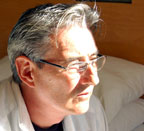 between the inside and outside of conceptually articulated space. Typically working in more ephemeral media of installation and earthworks, Biedul now brings the conceptual nature of his work into the permanent medium of painting and sculpture, which is the focus of his new three part series Spaces. For the first installment of the series entitled Rectangles, he designed a rectangular single point perspective installation and used the human form as an image and compositional tool to explore the conceptual space. between the inside and outside of conceptually articulated space. Typically working in more ephemeral media of installation and earthworks, Biedul now brings the conceptual nature of his work into the permanent medium of painting and sculpture, which is the focus of his new three part series Spaces. For the first installment of the series entitled Rectangles, he designed a rectangular single point perspective installation and used the human form as an image and compositional tool to explore the conceptual space.
Biedul uses nudes for his series Spaces, because clothing them would set them at a particular place in time. The second installment to the Spaces series is Squares. In it he will use five different women to illustrate conceptual nature of space. Not quite finished with Squares, he is working to ensure it doesn't appear that he is trying to put women in a box. Its just art he says, "no political message or anything whatsoever."
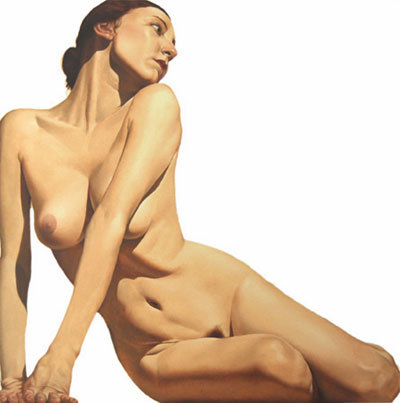
The third phase in the Spaces series is going to be more sculptural in dimension and is called Cubes. In it he'll use the same idea of creating space with a figure in space but for cubes. He admits it's going to be a bit difficult to find the right model because he will need one with "some meat on their bones."
Biedul chose the human body as a form because it is universally understood by all. There are no disagreements as to where the body starts and stops as a form.
"I can show the limitations of this space I created by simply using sticks or a line drawing, but using the human form is more powerful…in observing the art (rectangles and squares), it is important to understand first that the art itself is a definition of two-dimensional space. The next layer is the object that defines that space; in this case it is the figure in the painting. The edges of the canvas are the boundaries (or threshold) that defines the inside space and contains the art. In my work, there are no lines, background, color fields or image to extend beyond the threshold of the art."
You define yourself as a sculptor of space. Isn't this true for every sculptor?
The explorations that I am interested in are the articulation of conceptual space that is created inside the mind of the viewer. I am very interested in the gestalt world created by connecting the dots that surround us all the time. Traditional sculptors and architects are creating concrete mass and space with marble, clay, steel, glass and other "real" materials.
The term "Theoretical Architecture» reminds me on one side of Le Corbusier, on the other side it evokes a feeling of embracing an Utopia. Your idea of Theoretical Architecture was born traveling to a desert south of Death Valley. Could you say more about that, your motives?
My work is not so much a vision of utopia but rather an exploration into the very nature of art. Death Valley has been for me a place to experiment in the above stated explorations. The starkness of the landscape is a very neutral backdrop to help see the work clearly and to have a minimum of distractions. Because I try not to have a ecological impact on the site, I am forced to be very clean and quick. We (I get a lot of help from friends and like minded artists) get onto the site, build our pieces, enjoy them and critique them, then disassemble them and haul them away. It has been a fairly pure artistic experience. My motives have been for the most part selfish in that I have not shared the work with anyone but the people that are there at the time. This is something I would like to change in my future projects. I am planning on extensive documentation in the future.
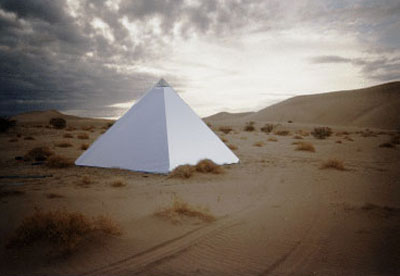
Although this refers to linguistics rather than to visual arts, let me ask you a question parallel to that. Adorno's conception of conceptually articulated experience extends the space of reasons beyond the space of concepts. It is argued that what is called the extended space of reasons is ultimately social; that representation, the aboutness of thought, serves expressive roles in a socially articulated space of reason-giving. Adorno's idea that the extended space of reasons implies the acknowledgment of what he refers to as the non-identical within conceptually articulated experience is thus reconstructed and defended. Such non-identity, it is claimed, is exhibited in successful artworks, which thereby ought to be counted as forms of reasoning. Do you see any parallel thoughts between that statement and your concept of conceptually articulated space?
The space I am referring to is inferred space so there are some parallels to Adorno's ideas but generally I like to pare down the experience to as clear an idea as possible. All art is gestalt to some degree. It is a very human experience, as it always has been. I don't think that any animal can be fooled into jumping out of a painted window no matter how realistic it is... we as humans create realism inside our minds' eye. This internal language and it's further possibilities are what interests me.
Phi was used by ancient Greeks in their sculpture and architecture, and for Leonardo da Vinci, the harmonic balance of a living body was best illustrated in his Vitruvian Man for De Divina Proportione. Isn't it exactly this divine portion you are creating by the use of Theoretical Architecture?
My rectangles were painted on a canvas that is a golden rectangle. This shape was chosen to complement the human figure and the manifestations of phi within the figure itself. On a more basic level, the canvas shape was chosen to help insure good composition within the process of posing the model. My other work is not so precise mathematically but aesthetic judgments seem to always work towards that structure. That exploration by da Vinci was about the nature of beauty and for his time, a very noble exploration indeed.
Looking at your first series created with rectangles makes me personally feel very anxious. It may be only my own impression, but there appears a lot of agony if not to say pain, caused by the obvious limitation of space.
The poses were very difficult and the model, Eric Underwood, was inspirational in his commitment. He understood what it was I was looking for and he was willing to put himself in difficult positions to achieve our mutual goal. This strain is evident in the rectangles and I felt that even though emotion is not a part of the content, I had to keep true to the image.
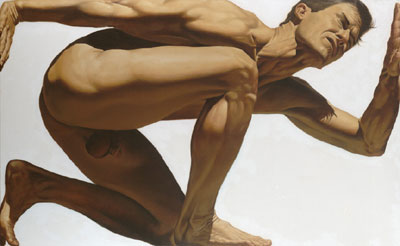
I feel more comfortable with the female body in the square. Again this is a personal intuition, seeing myself as a woman closer to being a round object, and a circle definitely fits easily into a square.
The squares were a different sort of experience in that I used five different models for the squares. The women approached the poses in a more relaxed way. They didn't seem to try to overpower the box but rather worked with it. Some of them commented on how the experience brought them back to childhood. For some it was akin to creating spaces out of cardboard boxes. For some of the models it was a languid interaction with the space and for some it became a platform for a personal artistic expression. It was a wonderful experience for me. The third and final phase of "spaces" will be large sculptures in bronze cubes.
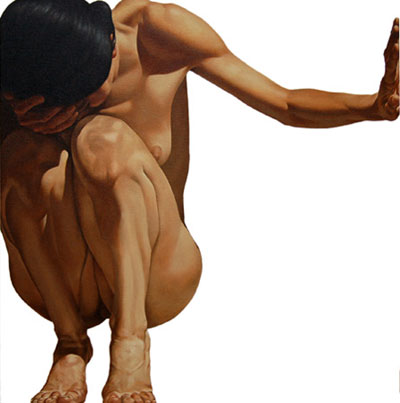
Why do you switch from the traditional oil on canvas that you've used as your medium so far, back to sculpture?
The squares and rectangles define a two-dimensional space, a finite plane. The art does not extend beyond the canvas (that is why the backgrounds are white or blank). For the final phase I want to articulate a three-dimensional space and thus sculpture is truly my only option if I am to continue using the figure as the articulator.
For more about Brian Biedul's work and dates of exhibitions, visit him at: www.biedul.com
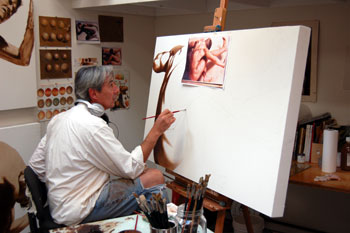
|
